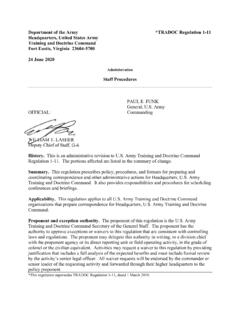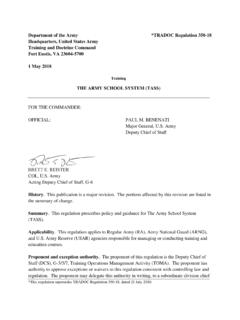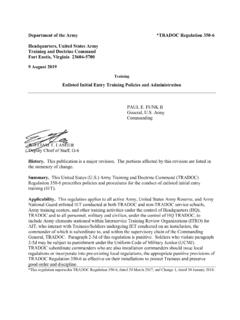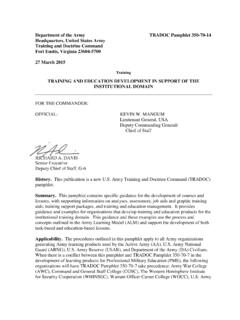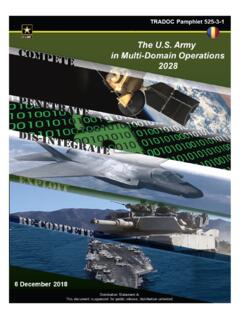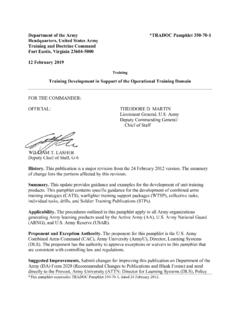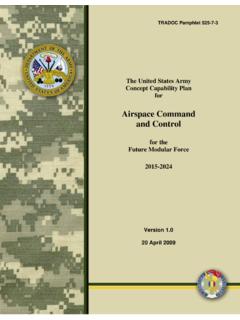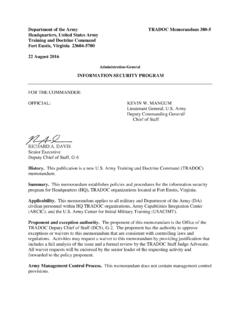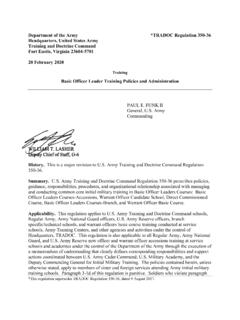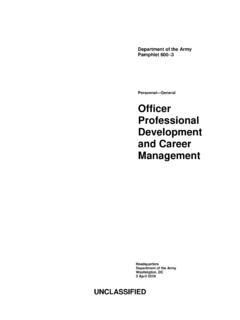Transcription of SYSTEM TRAINING INTEGRATION - United States Army
1 Department of the army TRADOC Pamphlet 350-70-13. headquarters , United States army TRAINING and Doctrine Command Fort Eustis, Virginia 23604-5000. 27 October 2014. TRAINING SYSTEM TRAINING INTEGRATION . FOR THE COMMANDER: OFFICIAL: KEVIN W. MANGUM. Lieutenant General, army Deputy Commanding General/. Chief of Staff RICHARD D. MONTIETH. Colonel, GS. Deputy Chief of Staff, G-6. History. This publication is a new army TRAINING and Doctrine Command (TRADOC). Pamphlet (TP). Summary. This pamphlet provides guidance and procedures for the TRAINING and education developer (TNGDEV) to develop TRAINING strategies, concepts, and plans that lead to the identification and documentation of integrated TRAINING and TRAINING support requirements.
2 This pamphlet addresses the Joint Capabilities INTEGRATION and Development SYSTEM (JCIDS), Defense Acquisition SYSTEM (DAS), analysis processes, supporting documentation, the TRAINING Support SYSTEM (TSS), the integrated TRAINING environment (ITE), TRAINING concepts and strategies, and SYSTEM TRAINING plan (STRAP) development. Applicability. This guide applies to TRADOC and organizations that execute the JCIDS. process for SYSTEM and non- SYSTEM TSS products, and non-TRADOC organizations that execute JCIDS for SYSTEM and non- SYSTEM TSS products under a memorandum of agreement (MOA) or memorandum of understanding (MOU) with TRADOC.
3 Proponent and exception authority. army Regulation (AR) 350-1 assigns the Commanding General (CG), TRADOC, the responsibility for army learning ( TRAINING and education). procedures contained herein. The proponent for this pamphlet is the Combined Arms Center . TRAINING (CAC-T), army TRAINING Support Center (ATSC)/ TRAINING Support Analysis and TRADOC Pamphlet 350-70-13. INTEGRATION Directorate (TSAID). The proponent has the authority to approve exceptions or waivers to this pamphlet consistent with controlling law and regulations, unless otherwise designated. Exceptions to policy are granted on an individual basis.
4 The commander or senior leader of the requesting activity must endorse all waiver requests before forwarding them through higher headquarters to the policy proponent. Requests must include requestor contact information; type of request (initial, extension, modification, appeal, or cancellation); specific regulation line items requested for waiver; unit, institution, or center/school affected; proposed alternative; justification; impact; expected benefits; anticipated effective dates; and duration requested. The proponent continually seeks innovation and process improvement. Significant process improvements and global exceptions will be considered for addendum to procedures prior to the next revision.
5 Suggested Improvements. Send comments and suggested improvements on Department of the army (DA) Form 2028 (Recommended Changes to Publications and Blank Forms) through The army TRAINING SYSTEM channels directly to CAC-T, ATSC, ATTN: ATIC-SA, Fort Eustis, Virginia 23604-5561 or electronically to Distribution. This publication is available only on the TRADOC Web site Summary of Change TRADOC Pamphlet 350-70-13. army TRAINING and Education Development: SYSTEM TRAINING INTEGRATION This new pamphlet, dated 27 October 2014- o Provides detailed guidance and procedures for SYSTEM TRAINING INTEGRATION (paras 1-5 and 2-3).
6 O Provides guidance and procedures to ensure INTEGRATION and interoperability across TRAINING Support SYSTEM products (paras 1-7, 3-14, 4-4, 5-1). o Provides guidance and procedures for SYSTEM TRAINING plan development (para 1-8, 2-4, and ch 10). o Provides guidance and procedures for TRAINING key performance parameter development (para 1-8 and ch 11). o Provides guidance on development of TRAINING Support SYSTEM requirements for new or improved systems (para 3-15b). o Provides guidance and procedures for TRAINING concepts and strategies (paras 5-1a and 8-1a). 2. TRADOC Pamphlet 350-70-13. Contents Page Chapter 1 SYSTEM TRAINING INTEGRATION Introduction.
7 7. 1-1. Purpose .. 7. 1-2. References .. 7. 1-3. Explanation of abbreviations and terms .. 7. 1-4. Scope .. 7. 1-5. Systems TRAINING INTEGRATION overview .. 7. 1-6. army TRAINING domains overview .. 9. 1-7. TRAINING support SYSTEM (TSS) resources overview .. 10. 1-8. SYSTEM TRAINING plans and key performance parameters .. 11. 1-9. Regulation, pamphlet and relation to other resources .. 12. Chapter 2 TRAINING Development for army Modernization TRAINING .. 13. 2-1. TRAINING development in support of the Joint Capabilities INTEGRATION and Development SYSTEM (JCIDS) .. 13. 2-2. TRAINING and education developer responsibilities.
8 13. 2-3. SYSTEM TRAINING INTEGRATION development analysis .. 17. 2-4. SYSTEM TRAINING plan (STRAP) overview .. 18. 2-5. New equipment TRAINING (NET) .. 20. 2-6. Doctrine and tactics TRAINING (DTT) .. 22. 2-7. Non- SYSTEM TRAINING devices (NSTDs) .. 23. 2-8. TRAINING test support package (TTSP) and test TRAINING certification plan (TTCP) .. 23. 2-9. Displaced equipment TRAINING (DET) and education development .. 25. 2-10. Systems TRAINING INTEGRATION / army Modernization TRAINING support to testing and evaluation .. 25. Chapter 3 SYSTEM TRAINING Concept and Strategy Development .. 26. 3-1. Overview .. 26. Section I.
9 27. SYSTEM TRAINING Concept Formulation .. 27. 3-2. Introduction .. 27. 3-3. SYSTEM TRAINING concept development .. 29. 3-4. Determining responsibility for materiel systems TRAINING development .. 30. 3-5. Determining assumptions .. 30. 3-6. Determining TRAINING constraints .. 32. 3-7. Determining site and location .. 33. 3-8. How to develop domain TRAINING concepts .. 33. 3-9. Determining target audience description .. 35. 3-10. Assessing environmental factors .. 36. 3-11. Drafting the TRAINING concept .. 37. Section II SYSTEM TRAINING Strategy Formulation .. 39. 3-12. SYSTEM TRAINING strategy defined .. 39. 3-13.
10 Preparing the SYSTEM TRAINING 40. 3-14. Developing a long-range TSS estimate.. 40. 3-15. How to develop a SYSTEM TRAINING 42. 3-16. SYSTEM TRAINING strategy development summary .. 46. 3-17. Conduct a job hazard analysis (risk assessment) .. 48. 3. TRADOC Pamphlet 350-70-13. Chapter 4 Integrated TRAINING Environment (ITE) .. 48. 4-1. Integrated TRAINING environment overview .. 48. 4-2. ITE capabilities overview .. 50. 4-3. Integrated architecture(s) (IA) .. 50. 4-4. TSS architectures and standards defined .. 50. 4-5. TSS architectures and standards .. 52. 4-6. Developing architectures and standards .. 53. 4-7. TRAINING infrastructure.
